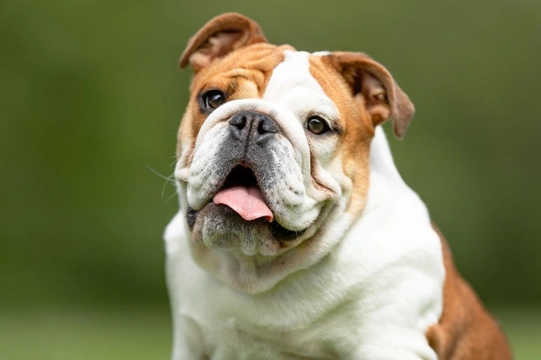
Does your dog have a tail pocket, and what does it mean if they do?
A tail pocket is present on the rump of some dogs with a specific style of tail, but it does not occur in all dogs with such tails, and can only be found in certain dog breeds and types.
It is important to find out if your dog has a tail pocket as you need to check it over and keep it clean, and also, to be aware of the potential problems that can arise in dogs with tail pockets too.
This article will explain how to tell if your dog has a tail pocket, and what it means if they do. Read on to learn more.
What is a tail pocket?
A tail pocket is a small space or indentation that some dogs have on their rump, in which their tail sits. This occurs in some dogs who have small tails (often but not always coiled or curled into what we call a screw tail/hemivertebrae) that appear to sit flat or almost flat on their rump, to the point they might look almost as if they do not have a tail at all.
The indentation or pocket is the space that such tails nestle in – so if your dog has a tail that is straight or curved or otherwise stands free of their rump rather than sitting closely on top of it, they don’t have a tail pocket. If your dog’s tail sits on the top of their rump, or if they appear to have only a stub of tail or a very tightly coiled one, they may have a tail pocket underneath.
What sort of dogs might have a tail pocket?
Tail pockets can be found in some dogs of breeds that come with a specific type of tail – a screw tail, or coiled tail. This can occur in breeds whose tails are short, sit on the top of the rump, and don’t generally move freely, often being coiled up tightly or appearing as if there is little to no tail there at all.
This is a trait within some dogs of certain breeds – but it does not mean that all dogs of these breeds have a tail pocket, or even in all cases, a screw tail!
The English bulldog is the breed most prone to having a tightly coiled tail and so, tail pocket, but this is also common in the French bulldog, Pug, and Boston terrier. Other breeds that can produce dogs with screw tails might have tail pockets too.
How would I know if my dog had a tail pocket?
If your dog has a curled or coiled tail and particularly if they come from one of the mentioned breeds, it is important to find out for sure if your dog has a tail pocket or not. This is because having a tail pocket can cause some problems like dermatitis and a heightened risk of skin fold infections within the pocket, and so they need to be checked, cleaned and dried regularly.
Additionally, if you’re in the market to buy a puppy of a breed that commonly has a screw tail and tail pocket, you might not be able to tell if your pup will have one when you’re visiting litters.
This is because tail pockets in dogs aren’t always present from birth, and can take up to six months of age to become apparent. So do go ahead and check the pups you view, but also make sure you find out if either or both parent dogs have a tail pocket, as this very much increases the chances of their litter inheriting the same trait.
How to check your dog for a tail pocket
When your dog is over the age of six months old, you can find out for sure if they have a tail pocket; if it is not evident by this age, the chances of them developing one later on are very low.
Tail pockets are pretty easy to find if they are present and you know what you’re looking for, which is specifically a shallow, natural indentation under the tail itself.
This means that with clean hands, you need to gently lift your dog’s tail or run your finger under it so it is between their rump and the underside of the tail, and you’ll feel the indentation or space if a tail pocket is present. Remember that some dogs with screw tails don’t have a huge range of movement of their tails, so be careful how you do this to avoid hurting them.
Some dogs find the tail pocket area quite sensitive too, so may react as if they’re being tickled, or they may find it irritating, so do proceed with caution.
Does having a tail pocket cause any problems for dogs?
If you do find that your dog has a tail pocket, this means you need to monitor it and keep it clean and dry, which means that choosing a dog with a tail pocket comes with additional care requirements.
Failing to keep the tail pocket clean can result in irritations and even infections, and this means you will need to commit to cleaning and drying the tail pocket daily in order to prevent this.
The build-up of dirt and debris that can occur otherwise, and of course, proximity to the anus, can result in some dogs suffering from regular and potentially hard to treat tail pocket infections, which might ultimately require amputation of the tail to prevent recurrences.



